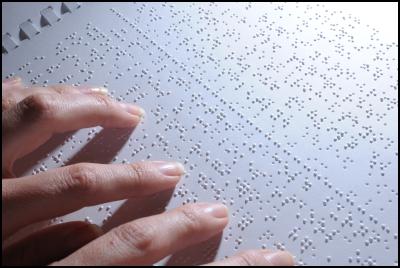Happy Birthday Louis Braille!
Braille gives blind people same access as sighted – Happy Birthday Louis Braille!

On 4 January in 1809, Louis Braille was born. After becoming blind in an accident at a young age, he invented braille, a simple system of raised dots read by touch. Braille is still used across the world today and even works with computer technology to give blind people access to the same information as their sighted peers.
Royal New Zealand Foundation of the Blind (RNZFB) Braille Awareness Consultant, Lisette Wesseling, says braille is the equivalent to print for a sighted person; making it a vital education and literacy tool.
“Through braille, blind and partially sighted individuals can achieve an education, get a job and maintain their independence. In fact, international research proves that 80% of all the blind people employed throughout the world use braille.”
RNZFB member, David Allen, is one New Zealand example. In his work as an adaptive communications instructor, David uses braille in the workplace every day to read and write.
“I use a special piece of equipment called a Braille Sense Plus – a small computer which can display braille. It allows me to read Microsoft Word, text and braille documents, surf the web, do my emails and check Facebook - all using braille.”
Braille training and transcription is one of the many essential services provided by the RNZFB for its 11,500 members across New Zealand.
The RNZFB also advocates to Government and other organisations, promoting access to information and literature for the blind. Unlike the US, Australia and the UK, there is no law in New Zealand to make provision of braille and other accessible formats mandatory. Worldwide, only 5% of information is available in formats that blind people can read.
In 2008 New Zealand signed up to the United Nations Convention on the Rights of Persons with Disabilities, which references braille under Article 21, Freedom of Expression and Opinion and Access to Information.
About Louis Braille:
• As a young
boy, Louis was blinded by an accident while playing in his
father's workshop.
• When he was 10 years old, Louis
was sent to Paris to attend a special school for the blind
where he invented the system of embossed writing which bears
his name.
• Louis spent most of his life struggling to
gain recognition for his system and have it adopted
officially. Those in authority were in favour of the
existing method of raised roman letters. Yet the merits of
his system were appreciated by blind students themselves,
who used it without official sanction for many
years.
• In 1854, two years after Louis’ death his
system finally gained official recognition. Its use spread
to other countries rapidly. Several rival systems of dot
writing appeared in the years that followed, but Louis
Braille's system has outlasted them all.
• Louis
Braille once said, “Braille is knowledge; knowledge is
power”.
About the Royal New Zealand Foundation of the
Blind:
• The RNZFB is New Zealand’s main provider of
sight loss services to blind and partially sighted
people.
• The RNZFB has more than 11,500 blind and
partially sighted members nationwide and each year nearly
1,100 New Zealanders who have become blind or experienced
serious sight loss register as members.
• The RNZFB has
recently published guidelines on how to ensure signage in
buildings is accessible which can be downloaded from
www.rnzfb.org.nz/signage.
• The RNZFB teaches braille
to blind adults – there are currently 26 adult braille
learners and around 400 in braille readers in New
Zealand.
ENDS


 University of Auckland: Online Gaming Review On Pacific Youth - Urgent Need For More Research
University of Auckland: Online Gaming Review On Pacific Youth - Urgent Need For More Research UCOL: UCOL Ākonga Awarded $28,000 In Freemasons Willson Lewis Scholarship
UCOL: UCOL Ākonga Awarded $28,000 In Freemasons Willson Lewis Scholarship Auckland Museum: Auckland Museum Announces Inaugural Matafatafa Aho Pacific Artist In Residence
Auckland Museum: Auckland Museum Announces Inaugural Matafatafa Aho Pacific Artist In Residence PHARMAC: Pharmac To Fund Medicines For Blood Cancers, Inflammatory Bowel Disease, Eczema And Arthritis
PHARMAC: Pharmac To Fund Medicines For Blood Cancers, Inflammatory Bowel Disease, Eczema And Arthritis  NZ Principals Federation: Principals Support NZEI's Call For Learning Support Boost
NZ Principals Federation: Principals Support NZEI's Call For Learning Support Boost NPDC: A Century On Stage - TSB Showplace To Celebrate 100 Years With Spectacular Show
NPDC: A Century On Stage - TSB Showplace To Celebrate 100 Years With Spectacular Show